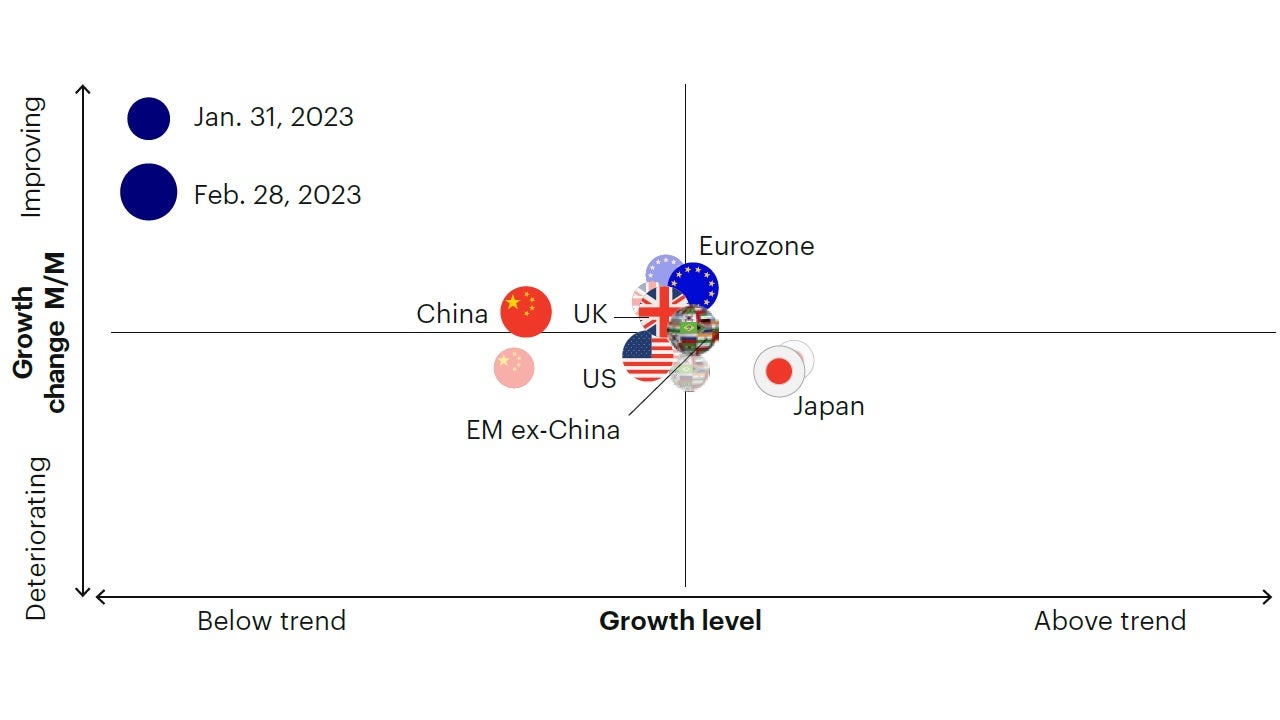Tactical Asset Allocation: March 2023

A reversal in market sentiment, driven by higher-than-expected inflation, leads us to position defensively for a low and decelerating growth environment in the near term. We reduce portfolio risk, overweighting fixed income relative to equities, underweighting emerging markets, and cyclical factors.
Synopsis
- Monetary policy expectations are being revised for a higher terminal rate. Market sentiment has reacted negatively, incorporating downward revisions to near-term growth prospects. Our framework moves to a contraction regime of below- trend and decelerating growth.
- Underweight risk relative to benchmark in the Global Tactical Allocation Model1, favoring fixed income over equities, developed markets over emerging markets, defensive sectors and factors. We favor investment grade over high yield, loans, and emerging market debt, and neutralize the US dollar exposure.
Macro update
Recent inflation prints have dispelled the notion that inflation could return quickly to the 2-3% range sufficient to justify a pause in the monetary tightening cycle. The latest US inflation reports for personal consumption expenditures (PCE), producer prices indices (PPI), business and consumer inflation surveys all came in above consensus expectations, causing a noticeable repricing in policy expectations. The Fed Funds rate is now expected to reach 5.40% by July 2023, compared to the 5% peak priced-in at the beginning of the year. Both 10-year real yields and breakeven inflation expectations have moved higher by 40bps and 20bps, respectively, over the past month, reflecting the higher cost of capital required to slow the economy and inflation. Indeed, US consumer spending and employment still show noticeable resilience. The repricing of short-term interest rates has pushed the yield curve further into inverted territory with an inversion of nearly 100bps between short and long maturities. Similarly, markets have raised expectations for the terminal rate of the European Central Bank (ECB) to reach 4% by early 2024, 50bps higher than expected two months ago, which would represent the highest policy rate in the history of the Eurozone. Overall, inflation is still likely to fall meaningfully over the course of 2023, but maybe not as fast as expected at the beginning of the year. Our barometer of US inflation momentum still points to falling inflationary pressures, but it’s off the lows since the most recent inflation reports (Figure 3).
Market sentiment has reacted negatively, likely reflecting the impact that a longer and deeper tightening cycle may have on growth, earnings, and profit margins going forward. Over the past month, cyclical assets have underperformed their more defensive alternatives, and this repricing has been consistent across all capital markets, with global equities underperforming fixed income, emerging markets underperforming developed markets, and credit spreads widening modestly. The US dollar has also strengthened, outperforming all major currencies year-to-date, and interrupting a four-month weakening trend that started in October 2022. Declining risk appetite, coupled with cyclical economic indicators below their long-term average, moves our macro regime framework back into a contraction regime, last registered between August – November 2022.
European economic indicators continue to rebound led by consumer confidence, an improving inventory cycle, and rising production expectations. Evidence of cyclical divergence between the US and the rest of the world continues to grow as leading indicators in the US point to a weakening housing and industrial sector, partially offset by rising consumer sentiment. Cyclical indicators in emerging markets have also improved over the past month, led by Asia, with rising consumer confidence, business surveys and industrial activity, while housing and international trade remain soft (Figure 1 and Figure 2).
Declining risk appetite, coupled with cyclical economic indicators below their long-term average, moves our macro regime framework back into a contraction regime, last registered between August – November 2022.

European economic indicators continue to rebound led by consumer confidence, an improving inventory cycle, and rising production expectations.

Sources: Bloomberg L.P., Macrobond. Invesco Investment Solutions research and calculations. Proprietary leading economic indicators of Invesco Investment Solutions. Macro regime data as of Feb. 28, 2023. The Leading Economic Indicators (LEIs) are proprietary, forward-looking measures of the level of economic growth. The Global Risk Appetite Cycle Indicator (GRACI) is a proprietary measure of the markets’ risk sentiment.
Over the past month, cyclical assets have underperformed their more defensive alternatives, and this repricing has been consistent across all capital markets, with global equities underperforming fixed income, emerging markets underperforming developed markets, and credit spreads widening modestly.

Sources: Bloomberg L.P., MSCI, FTSE, Barclays, JPMorgan, Invesco Investment Solutions research and calculations, from Jan. 1, 1992 to Feb. 28, 2023. The Global Leading Economic Indicator (LEI) is a proprietary, forward-looking measure of the growth level in the economy. A reading above (below) 100 on the Global LEI signals growth above (below) a long-term average. The Global Risk Appetite Cycle Indicator (GRACI) is a proprietary measure of the markets’ risk sentiment. A reading above (below) zero signals a positive (negative) compensation for risk taking in global capital markets in the recent past. Past performance does not guarantee future results.
Overall, inflation is still likely to fall meaningfully over the course of 2023, but maybe not as fast as expected at the beginning of the year.
Overall, growth remains low, and the odds of a deceleration remain elevated, as the long and variable lags of monetary policy are still making their way into the economy, as evidenced by higher mortgage rates and tighter lending standards. The rapid repricing in favor of risky assets at the start of the year, coupled with disappointing inflation reports, suggests sentiment may have run “a little too far, too fast”, as the optimistic scenario of falling inflation with resilient labor markets is being challenged.

Sources: Bloomberg L.P. data as of Feb. 23, 2023, Invesco Investment Solutions calculations. The US Inflation Momentum Indicator (IMI) measures the change in inflation statistics on a trailing three-month basis, covering indicators across consumer and producer prices, inflation expectation surveys, import prices, wages, and energy prices. A positive (negative) reading indicates inflation has been rising (falling) on average over the past three months.
Investment positioning
We transitioned the portfolio to a more defensive positioning, reflecting expectations for an environment of low and decelerating growth. We moved to an underweight risk stance relative to benchmark in the Global Tactical Allocation Model, favoring fixed income over equities, defensive sectors and factors, and underweighting emerging market equities relative to developed markets. We underweight credit risk and overweight duration, favoring investment grade and government bonds relative to high yield, loans, and emerging market debt. We neutralized foreign currency exposure versus the US dollar (Figure 4, 5, 6, 7). In particular:
- Within equities we overweight defensive factors with low operating leverage and lower exposure to economic risk such as quality and low volatility, at the expense of cyclical exposures such as value and small/mid-caps. Similarly, we favor defensive sectors such as health care, staples, utilities, and technology, at the expense of financials, industrials, materials, and energy. From a regional perspective, we move to a moderate underweight stance in emerging markets given the decline in risk appetite but continue to favor developed ex-US equities relative to US equities, driven by continued cyclical divergence between the regions, with positive momentum in Europe relative to the US, and still favorable currency valuation.
- In fixed income, we reduce credit risk and overweight duration, favoring investment grade credit and government bonds, underweighting riskier sectors such as loans, high yield, and emerging markets debt, given the downshift in global risk appetite. Income strategies remain attractive, especially relative to equities, given the higher level of real and nominal yields, and spreads at historical long-term averages. In this low growth environment with transient and data-dependent investor sentiment, investment grade provides a defensive solution with attractive yields between 5-6%. We continue to favor nominal treasuries relative to inflation-linked bonds.
- In currency markets we close our underweight exposure to the US dollar and move to neutral. Renewed widening in rate differentials in favor of the US offsets the downward pressure on the greenback resulting from above-consensus growth in Europe. Within developed market currencies we favor the euro, the British pound, Norwegian kroner, and Swedish krona relative to the Swiss Franc, Japanese yen, Australian and Canadian dollars. In EM we favor high yielders with attractive valuations as the Colombian peso and Brazilian real, relative to low yielding currencies as the Korean won, Taiwan dollar and Chinese renminbi.

Source: Invesco Investment Solutions, March 1, 2023. DM = developed markets. EM = emerging markets. Non-USD FX refers to foreign exchange exposure as represented by the currency composition of the MSCI ACWI Index. For illustrative purposes only.

Source: Invesco Investment Solutions, March 1, 2023. For illustrative purposes only. Neutral refers to an equally weighted factor portfolio.

Source: Invesco Investment Solutions, March 1, 2023. For illustrative purposes only. Sector allocations derived from factor and style allocations based on proprietary sector classification methodology. As of November 30th, 2022, Cyclicals: energy, financials, industrials, materials; Defensives: consumer staples, health care, information technology, real estate, communication services, utilities; Neutral: consumer discretionary.

Source: Invesco Investment Solutions, March 1, 2023. For illustrative purposes only. Currency allocation process considers four drivers of foreign exchange markets: 1) US monetary policy relative to the rest of the world, 2) global growth relative to consensus expectations, 3) currency yields (i.e., carry), 4) currency long-term valuations
当資料ご利用上のご注意
当資料は情報提供を目的として、インベスコ・アセット・マネジメント株式会社(以下、「当社」)のグループに属する運用プロフェッショナルが英文で作成したものであり、法令に基づく開示書類でも金融商品取引契約の締結の勧誘資料でもありません。内容には正確を期していますが、必ずしも完全性を当社が保証するものではありません。また、当資料は信頼できる情報に基づいて作成されたものですが、その情報の確実性あるいは完結性を表明するものではありません。当資料に記載されている内容は既に変更されている場合があり、また、予告なく変更される場合があります。当資料には将来の市場の見通し等に関する記述が含まれている場合がありますが、それらは資料作成時における作成者の見解であり、将来の動向や成果を保証するものではありません。また、当資料に示す見解は、インベスコの他の運用チームの見解と異なる場合があります。過去のパフォーマンスや動向は将来の収益や成果を保証するものではありません。当社の事前の承認なく、当資料の一部または全部を使用、複製、転用、配布等することを禁じます。
受託資産の運用に係るリスクについて
受託資産の運用にはリスクが伴い、場合によっては元本に損失が生じる可能性があります。各受託資産へご投資された場合、各受託資産は価格変動を伴う有価証券に投資するため、投資リスク(株価の変動リスク、株価指数先物の価格変動リスク、公社債にかかるリスク、債券先物の価格変動リスク、コモディティにかかるリスク、信用リスク、デフォルト・リスク、流動性リスク、カントリー・リスク、為替変動リスク、中小型株式への投資リスク、デリバティブ.金融派生商品.に関するリスク等)による損失が生じるおそれがあります。ご投資の際には、各受託資産の契約締結前書面、信託約款、商品説明書、目論見書等を必ずご確認下さい。
受託資産の運用に係る費用等について
投資一任契約に関しては、次の事項にご留意ください。【投資一任契約に係る報酬】直接投資の場合の投資一任契約に係る報酬は契約資産額に対して年率0.88%(税込)を上限とする料率を乗じた金額、投資先ファンドを組み入れる場合の投資一任契約に係る報酬は契約資産額に対して年率0.605%(税込)を上限とする料率を乗じた金額が契約期間に応じてそれぞれかかります。また、投資先外国籍ファンドの運用報酬については契約資産額に対して年率1.30%を上限とする料率を乗じた金額が契約期間に応じてかかります。一部の受託資産では投資一任契約に加えて成功報酬がかかる場合があります。成功報酬については、運用戦略および運用状況などによって変動するものであり、事前に料率、上限額などを表示することができません。【特定(金銭)信託の管理報酬】当該信託口座の受託銀行である信託銀行に管理報酬をお支払いいただく必要があります。具体的料率については信託銀行にご確認下さい。【組入有価証券の売買時に発生する売買委託手数料等】当該費用については、運用状況や取引量等により変動するものであり、事前に具体的な料率、金額、上限または計算方法等を示すことができません。【費用合計額】上記の費用の合計額については、運用状況などによって変動するものであり、事前に料率、上限額などを表示することができません。
20230214-2732532-JP
そのほかの投資関連情報はこちらをご覧ください。https://www.invesco.com/jp/ja/institutional/insights.html

